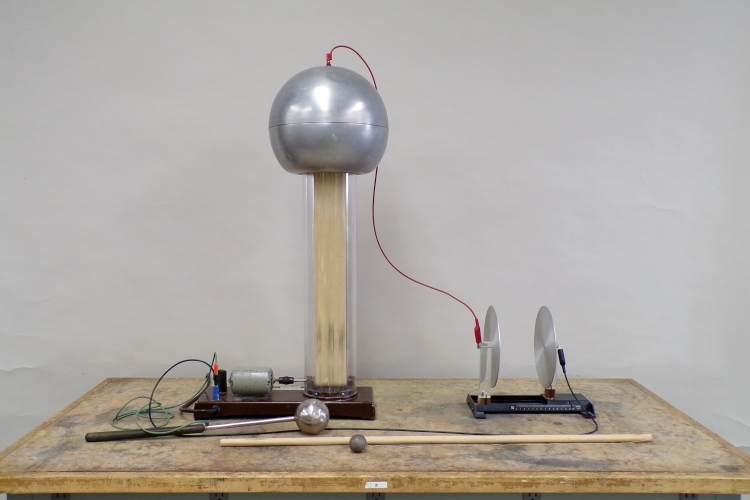
A ping pong ball coated with a conductive coating is attached by thread to a long wooden dowel. Sitting next to the Van de Graaff generator is an apparatus with two circular plates set parallel to each other, one of which is grounded, and the other of which is connected to the dome of the generator. Hold the wooden rod so that the ball hangs between the plates. When you turn on the Van de Graaff generator, the ball begins to oscillate rapidly between the plates. Important! Always use the grounded wand to turn the generator on and off.
This demonstration is based on an apparatus that Benjamin Franklin used to detect atmospheric electricity and perform experiments to determine the sign of the charge in storm clouds, commonly known as Franklin’s Bells. You can find a description of this apparatus and a note on Franklin’s experiments with it on page 44 of Benjamin Franklin and Lightning Rods, by E. Philip Krider, which appeared in the January, 2006 edition of Physics Today. This device consisted of two bells, one of which was connected to a long insulated metal rod attached to the roof of Franklin’s house, and the other of which was connected to a rod set in the ground. Between the two bells hung a small metal ball, suspended on a silk thread. When an electrically charged (or polarized) cloud approached, either by induction or corona discharge it would charge the bell connected to the rod on the roof. This would induce charge of the opposite sign in the other bell. The ball would be attracted to one of the bells, and move toward it. As soon as the ball touched the bell, it had charge of the same sign as that on the bell, and was repelled by it toward the other bell. (See demonstration 56.09 -- Charge pith balls.) When it touched the other bell, it deposited its charge there (or withdrew charge from the bell) and now had charge of the same sign as on that bell, and was repelled by it and again attracted to the first bell. The ball thus oscillated between the two bells. Franklin wrote in a letter to Peter Collinson (click on the link to accept the license for fair use) that he had made this device in September, 1752. Apparently, a Benedictine monk named Andrew Gordon made a similar device in about 1745. (See, for example, American Journal of Physics 69, 50 (2001).)
According to Franklin’s description, the bells started and stopped ringing on their own, in response to changes in the electrical conditions in the atmosphere. The painting reproduced in the Physics Today article linked above shows the bells as being round, with the small ball set closer to one bell than the other. Given the nonuniform field between the bells, with the ball so situated, if one of the bells became charged, the ball should be polarized so as to be attracted to the near bell, which would set the system oscillating. With the two flat plates in this demonstration, the field is uniform, so if you set the ball between the plates and then turn on the generator (or set it there while the generator is running), it is not obvious that it should be attracted to one plate or the other. The thread on which the ball is suspended, however, passes through the field around the dome of the Van de Graaff generator. This field is not uniform, so the thread, which is polarized by the field, is attracted by the dome of the generator, and bows slightly toward it. This causes the ball to drift toward the plate that is nearer to the dome. (This may also have happened with the silk string suspending the ball in Benjamin Franklin’s apparatus.) Also, depending on how you set the ball between the plates, it may drift toward one plate or the other. (That is, if it is swinging slightly along the line between the plates, this may cause it to move toward one plate or the other.) As soon as it touches that plate, charge from the plate flows onto the ball (or vice versa), and now having charge of the same sign as that on the plate, the ball is repelled toward the other plate. The other plate has charge of the opposite sign, and attracts the ball. When the ball touches that plate, the same process occurs as before, and the ball is repelled back toward the first plate, to which it is now attracted. The ball thus oscillates rapidly between the two plates.